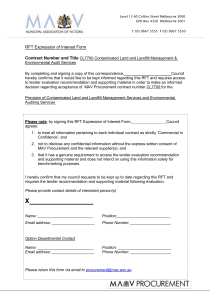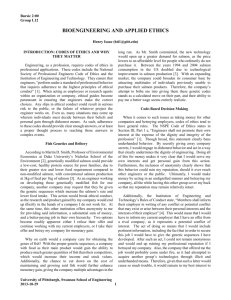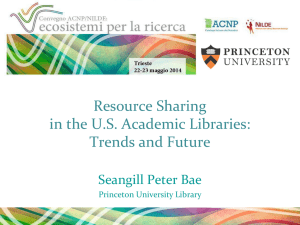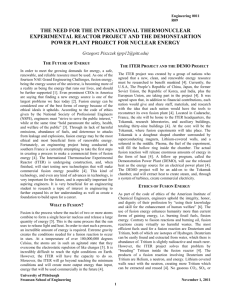Engineering Ethics - University of Pittsburgh
advertisement
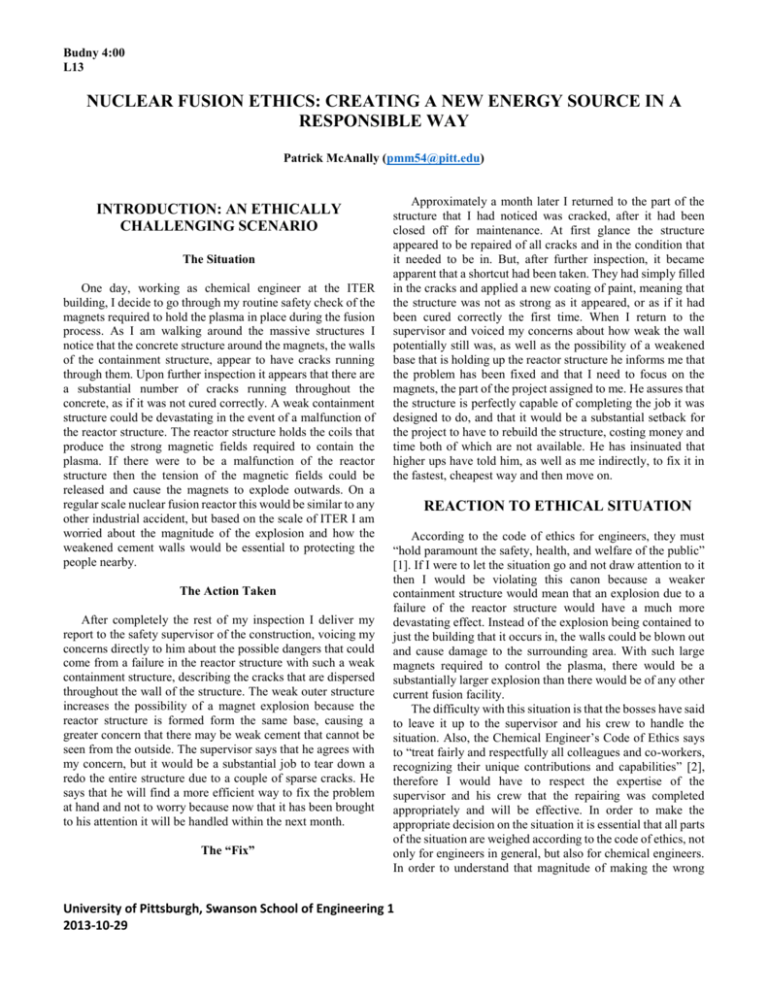
Budny 4:00 L13 NUCLEAR FUSION ETHICS: CREATING A NEW ENERGY SOURCE IN A RESPONSIBLE WAY Patrick McAnally (pmm54@pitt.edu) INTRODUCTION: AN ETHICALLY CHALLENGING SCENARIO The Situation One day, working as chemical engineer at the ITER building, I decide to go through my routine safety check of the magnets required to hold the plasma in place during the fusion process. As I am walking around the massive structures I notice that the concrete structure around the magnets, the walls of the containment structure, appear to have cracks running through them. Upon further inspection it appears that there are a substantial number of cracks running throughout the concrete, as if it was not cured correctly. A weak containment structure could be devastating in the event of a malfunction of the reactor structure. The reactor structure holds the coils that produce the strong magnetic fields required to contain the plasma. If there were to be a malfunction of the reactor structure then the tension of the magnetic fields could be released and cause the magnets to explode outwards. On a regular scale nuclear fusion reactor this would be similar to any other industrial accident, but based on the scale of ITER I am worried about the magnitude of the explosion and how the weakened cement walls would be essential to protecting the people nearby. The Action Taken After completely the rest of my inspection I deliver my report to the safety supervisor of the construction, voicing my concerns directly to him about the possible dangers that could come from a failure in the reactor structure with such a weak containment structure, describing the cracks that are dispersed throughout the wall of the structure. The weak outer structure increases the possibility of a magnet explosion because the reactor structure is formed form the same base, causing a greater concern that there may be weak cement that cannot be seen from the outside. The supervisor says that he agrees with my concern, but it would be a substantial job to tear down a redo the entire structure due to a couple of sparse cracks. He says that he will find a more efficient way to fix the problem at hand and not to worry because now that it has been brought to his attention it will be handled within the next month. The “Fix” Approximately a month later I returned to the part of the structure that I had noticed was cracked, after it had been closed off for maintenance. At first glance the structure appeared to be repaired of all cracks and in the condition that it needed to be in. But, after further inspection, it became apparent that a shortcut had been taken. They had simply filled in the cracks and applied a new coating of paint, meaning that the structure was not as strong as it appeared, or as if it had been cured correctly the first time. When I return to the supervisor and voiced my concerns about how weak the wall potentially still was, as well as the possibility of a weakened base that is holding up the reactor structure he informs me that the problem has been fixed and that I need to focus on the magnets, the part of the project assigned to me. He assures that the structure is perfectly capable of completing the job it was designed to do, and that it would be a substantial setback for the project to have to rebuild the structure, costing money and time both of which are not available. He has insinuated that higher ups have told him, as well as me indirectly, to fix it in the fastest, cheapest way and then move on. REACTION TO ETHICAL SITUATION According to the code of ethics for engineers, they must “hold paramount the safety, health, and welfare of the public” [1]. If I were to let the situation go and not draw attention to it then I would be violating this canon because a weaker containment structure would mean that an explosion due to a failure of the reactor structure would have a much more devastating effect. Instead of the explosion being contained to just the building that it occurs in, the walls could be blown out and cause damage to the surrounding area. With such large magnets required to control the plasma, there would be a substantially larger explosion than there would be of any other current fusion facility. The difficulty with this situation is that the bosses have said to leave it up to the supervisor and his crew to handle the situation. Also, the Chemical Engineer’s Code of Ethics says to “treat fairly and respectfully all colleagues and co-workers, recognizing their unique contributions and capabilities” [2], therefore I would have to respect the expertise of the supervisor and his crew that the repairing was completed appropriately and will be effective. In order to make the appropriate decision on the situation it is essential that all parts of the situation are weighed according to the code of ethics, not only for engineers in general, but also for chemical engineers. In order to understand that magnitude of making the wrong University of Pittsburgh, Swanson School of Engineering 1 2013-10-29 Patrick McAnally decision it is important to know what the fusion process is and how it differs in the ITER facility than anywhere else. superconductors. The whole magnetic process is much larger than the Joint European Torus, “with a confinement volume over four times JET's, ringed by magnetic fields almost three times as strong” [6], it is apparent how much stronger the magnets are than any other fusion facility. Superconductors were intensely researched by Oxford Instruments, a superconductor specialist, who said they would make it cheaper to run the tokamak, as it would “reduce the amount of electricity needed to produce the magnetic fields” [7]. A key aspect of ITER’s ability to produce an increased amount of energy is the vacuum vessel. This vessel determines the volume of the fusion plasma, meaning that the larger the vessel the more power produced. The ITER vacuum vessel will be “twice as large and sixteen times as heavy as any previous tokamak” [8] making it capable of a much greater magnitude of energy. The incredible size difference of ITER from any other fusion facility in the world gives it an edge on the rest because when it comes to fusion, the larger the facility the more energy that it is capable of producing. THE PROCESS OF FUSION The goal of ITER project is to create the largest scale center for the fusion process in order to create the first successfully efficient fusion plant. The main focus of the fusion process is to use the smallest amount of energy in order to produce an exponentially greater amount of energy. The theory behind fusion is based on the famous equation: E=mc2, meaning that a very small amount of mass can generate an enormous amount of energy because the speed of light is so great. Fusion differs from fission in that fission uses heavy uranium nuclei which are split apart in order to create lighter elements, as well as causing a tiny portion of the mass to turn directly into energy. Fusion is essentially the same process but backwards, using hydrogen nuclei to create helium ions that weigh slightly less. ITER: HIGER RISK DUE TO A LARGER PROJECT ETHICAL SOLUTIONS In order to come to a conclusion that respects the codes of ethics, both the engineering one as well as the code specific to chemical engineers, all sides of the situation must be weighed against both codes. The chemical engineering code of ethics states that engineers need to “treat fairly and respectfully all colleagues and co-workers, recognizing their unique contributions and capabilities” [2]. Abiding by this code means respecting that the people who are in charge of the safety of the operation as well as the repairing of the reported issue by accepting that they were employed for a reason and are informed in their work. It is also states that engineers should only “perform professional services only in areas of their competence” [2]. Other canons of the code must be weighed against these two, supporting the other side that it is your duty to ensure that the problem is sufficiently fixed. The top engineering canon states that engineers must “Hold paramount the safety, health, and welfare of the public” [1]. If I believed that the repair job was not completed correctly than it would go against this canon to listen to the supervisor and leave it as is since there could be a possible risk to the public if the structure were to fail in the event of an explosion. If I am to follow to code of ethics than it is necessary to consider if this could be viewed as deceitful, as the fifth canon says that engineers need to “avoid deceptive acts” [1]. By allowing a mediocre fix to a possibly serious problem to stand, I would be violating two canons of the code of ethics by possibly putting the safety of the public in danger, no matter how small the chance, as well as allowing a fix such as this to slip by. There are parts of both codes that support either decision, but in the end it is necessary to weigh which is more important, the safety of the public, which in my eyes may be in danger, or respecting the decisions of colleagues who are trained in the field of the project that is felt to be inappropriately completed. The technology itself that is being used in the ITER project is not incredibly groundbreaking, but the magnitude of the project is what makes it unique. The size of ITER is essential because, as Geoff Brumfiel, science correspondent of NPR radio, says “the bigger the tokamak, the hotter the plasma can get, and the more efficient fusion becomes” [3]. The ITER facility “includes concrete-framed buildings with a combined footprint of 21,000 sq. m” [4], meaning that there is a huge area where a situation such as the hypothetical one above suggests could occur. The main goal of fusion is to obtain the greatest efficiency, meaning to put in as little energy in order to generate the greatest amount. The ITER facility is designed to use a magnetic cage called a tokamak in order to suspend the plasma of hydrogen ions as they are heated. The tokamak is a metal doughnut which is circled by loops of coil in order to generate magnetic fields. These magnetic fields are what keep the plasma suspended, but there is a risk that comes from these magnets. Because the plasma is such high energy, it takes a great deal of energy in order to keep it suspended. The increase of energy that is required means that there is a slight increase in risk for a structural failure which would cause the magnetic power to be released and cause a type of explosion. These magnets are essential though, because keeping the plasma suspended is key because in order for fusion to occur the plasma of hydrogen atoms must be heated to, as described by Dr. Craig C. Freudenrich who received a Ph.D. for the University of Pittsburgh, “temperatures of about 100 million Kelvin, approximately six times hotter than the sun’s core” [5], which is hot enough to melt any solid. Fusion has been shown to occur under 20 MW of power generation, but ITER plans on scaling that up to 500 MW of generation. The tokamak that is used in ITER’s fusion process is the largest in the world, containing 18 magnets made from 2 Patrick McAnally TER+fusion+reactor%29&rft.jtitle=Scientific+American&rft. au=Brumfiel%2C+Geoff&rft.date=2012-0601&rft.pub=Scientific+American%2C+Inc&rft.issn=00368733&rft.eissn=19467087&rft.volume=306&rft.issue=6&rft.spage=56&rft.externa lDBID=n%2Fa&rft.externalDocID=293363006&paramdict= en-US [4] P. Reina. (2012) “Fusion Plant Takes Shape.” ENR: Engineering News-Record. (Online Article) http://rt4rf9qn2y.search.serialssolutions.com/?ctx_ver=Z39.8 8-2004&ctx_enc=info%3Aofi%2Fenc%3AUTF8&rfr_id=info:sid/summon.serialssolutions.com&rft_val_fmt =info:ofi/fmt:kev:mtx:journal&rft.genre=article&rft.atitle=Fu sion+plant+takes+shape.%28The+largestever+nuclear+reactor+of+its+kind%2C+a+%241.3+billion+p roject+is+going+up+in+France%29&rft.jtitle=ENR&rft.au= Reina%2C+Peter&rft.date=2012-0326&rft.pub=The+McGrawHill+Companies%2C+Inc&rft.issn=08919526&rft.volume=268&rft.issue=9&rft.spage=8&rft.external DBID=n%2Fa&rft.externalDocID=290149129&paramdict=e n-US [5] C. Freudenrich (2013) “How Nuclear Fusion Reactors Work.” Howstuffworks.com (Website) http://science.howstuffworks.com/fusion-reactor2.htm [6] ITER (2013) “ITER” ITER.org (Website) http://www.iter.org/ [7] S. Nathan (2011) “Nuclear Fusion: Path to Power” The Engineer (Online Article) http://go.galegroup.com/ps/i.do?action=interpret&id=GALE %7CA264375631&v=2.1&u=upitt_main&it=r&p=AONE&s w=w&authCount=1 [8] D. Hambling (2011) “Nuclear Fusion Goes Small.” New Scientist (Online Journal Article) http://www.sciencedirect.com/science/article/pii/S026240791 1619702 [9]Ellis, Patti (2013) “Corporate Ethics Education Yields Rewards” National Defense (Online Article) http://go.galegroup.com/ps/i.do?id=GALE%7CA339853916 &v=2.1&u=upitt_main&it=r&p=AONE&sw=w [10] Wyndham, Jessica (2012) “Freedom and Engineering For All” Mechanical Engineering-CIME (Online Article) http://rt4rf9qn2y.search.serialssolutions.com/?ctx_ver=Z39.8 8-2004&ctx_enc=info%3Aofi%2Fenc%3AUTF8&rfr_id=info:sid/summon.serialssolutions.com&rft_val_fmt =info:ofi/fmt:kev:mtx:journal&rft.genre=article&rft.atitle=F REEDOM+AND+ENGINEERING+FOR+ALL&rft.jtitle=M echanical+Engineering&rft.au=Jessica+M+Wyndham&rft.da te=2012-0901&rft.pub=American+Society+of+Mechanical+Engineers&r ft.issn=0025-6501&rft.eissn=19435649&rft.volume=134&rft.issue=9&rft.spage=32&rft.externa lDocID=2759883761&paramdict=en-US [11] Else, Holly (2012) “Safer Nuclear Power Set to Become a Reality” Professional Engineering Magazine (Online Article) CONCLUSION: FUSION AND THE ETHICS INVOLVED The code of ethics for engineers pertains to almost all engineering situations, nuclear fusion being no exception. The way the fusion process has been handled so far has abided by the canons set forth by both the Engineering Code of Ethics as well as the Chemical Engineers’ Code of Ethics. The businesses that employ engineers require that they follow the specific ethics codes as the current view is that a “culture that embraces a core set of values is essential to being successful in business today” [9]. The canons are essential to all of the work that engineers do today since “ethical standards guide the work of engineers” [10]. Fusion process respects the canons from the first which says that engineers must “Hold paramount the safety, health, and welfare of the public” [1]. Fusion abides by this canon more so than other nuclear processes, such as fission, because there is a very small amount of nuclear waste that is produced. Fusion is “a sustainable and non-polluting power source” [11] which is a perfect representation of the first canon. Alongside the Engineering Code of Ethics, fusion workers must abide by other codes such as the Chemical Engineers’ Code of Ethics. With the chemical processes that occur throughout the fusion process, chemical engineers are an essential part of the project. With a specialization of engineering comes a specialization of the code of ethics. Fusion power abides by the Chemical Engineers’ Code of Ethics in the sense that much of it is similar to Engineer’s Code, but there is a specific difference that should be pointed out. Chemical engineers are to use “their knowledge and skill for the enhancement of human welfare” [2]. By researching the fusion process they abide by this canon as the success of fusion would mean a power source unlike any other that currently exists. With this success the energy production of the world would be forever changed. The fusion process not only abides by the general Engineering Code of Ethics, but is representative of the code specific to engineers as well, making it not only a viable energy source but also an ethical option as well. REFERENECES [1] National Society of Professional Engineers (1946) (Revised 2007) “NSPE Code of Ethics for Engineers” NSPE.org (Website) http://www.nspe.org/Ethics/CodeofEthics/index.html [2] American Institute of Chemical Engineers (2013) “Code of Ethics” AIChE.com (Website) http://www.aiche.org/about/code-ethics [3] G. Brumfiel (2012) “Fusions Missing Pieces.” Scientific American (Online Article) http://rt4rf9qn2y.search.serialssolutions.com/?ctx_ver=Z39.8 8-2004&ctx_enc=info%3Aofi%2Fenc%3AUTF8&rfr_id=info:sid/summon.serialssolutions.com&rft_val_fmt =info:ofi/fmt:kev:mtx:journal&rft.genre=article&rft.atitle=Fu sion%27s+missing+pieces.%28challenges+hampering+the+I 3 Patrick McAnally http://go.galegroup.com/ps/i.do?id=GALE%7CA284449945 &v=2.1&u=upitt_main&it=r&p=AONE&sw=w ADDITIONAL SOURCES A. Grant (2013) “How America’s Latest Attempt at Fusion Power Fizzled.” Science News (Online Article) http://go.galegroup.com/ps/i.do?action=interpret&id=GALE %7CA327356765&v=2.1&u=upitt_main&it=r&p=AONE&s w=w&authCount=1 ACKNOWLEDGMENTS I would like to thank all of the librarians at the Bevier Library for assisting me in finding appropriate sources. I would also like to thank my fellow engineers for assisting me in the editing and wording of this paper. 4
